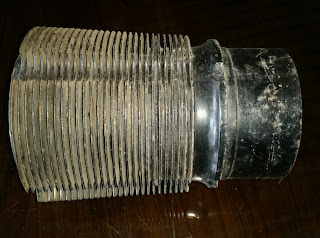Crankcase Sections
Crankcase is foundation of an engine. It contains the bearings and bearing supports in which the crankshaft revolves. Crankcase supporting itself and provide a tight enclosure for the lubricating oil and various external and internal mechanisms of the engine.
Provides support for attachment of the cylinder assemblies, and the powerplant to the aircraft.
Rigid and strong to prevent misalignment of the crankshaft and its bearings.
Made of Cast or forged aluminum alloy because it is light and strong.
Crankcase is subjected to many variations of mechanical loads and other forces. Since the cylinders are fastened to the crankcase, the tremendous forces placed on the cylinder tend to pull the cylinder off the crankcase.
The unbalanced centrifugal and inertia forces of the crankshaft acting through the main bearings subject the crankcase to bending moments which change continuously in direction and magnitude.
The machined surfaces on which the cylinders are mounted are called cylinder pads. They are provided with a suitable means of retaining or fastening the cylinders to the crankcase.
The general practice in securing the cylinder flange to the pad is to mount studs in threaded holes in the crankcase. The inner portion of the cylinder pads are sometimes chamfered
or tapered to permit the installation of a large rubber O-ring around the cylinder skirt, which effectively seals the joint between the cylinder and the crankcase pads against oil leakage.
a small chamber is located on the bottom of the nose section to collect the oil. This is called
the nose section oil sump.
The crankshaft mainbearings must be supported rigidly in the crankcase. This usually is accomplished by means of transverse webs in the crankcase, one for each main bearing. The webs form an integral part of the structure and, in addition to supporting the main bearings, add to the strength of the entire case.
Crankcase is divided into two sections in a longitudinal plane. This division may be in the plane of the crankshaft so that one-half of the main bearing (and sometimes camshaft
bearings) are carried in one section of the case and the other half in the opposite section. Another method is to divide the case in such a manner that the main bearings
are secured to only one section of the case on which the cylinders are attached, thereby providing means of removing a section of the crankcase for inspection without disturbing
the bearing adjustment.
Provides support for attachment of the cylinder assemblies, and the powerplant to the aircraft.
Rigid and strong to prevent misalignment of the crankshaft and its bearings.
Made of Cast or forged aluminum alloy because it is light and strong.
Crankcase is subjected to many variations of mechanical loads and other forces. Since the cylinders are fastened to the crankcase, the tremendous forces placed on the cylinder tend to pull the cylinder off the crankcase.
The unbalanced centrifugal and inertia forces of the crankshaft acting through the main bearings subject the crankcase to bending moments which change continuously in direction and magnitude.
The machined surfaces on which the cylinders are mounted are called cylinder pads. They are provided with a suitable means of retaining or fastening the cylinders to the crankcase.
The general practice in securing the cylinder flange to the pad is to mount studs in threaded holes in the crankcase. The inner portion of the cylinder pads are sometimes chamfered
or tapered to permit the installation of a large rubber O-ring around the cylinder skirt, which effectively seals the joint between the cylinder and the crankcase pads against oil leakage.
a small chamber is located on the bottom of the nose section to collect the oil. This is called
the nose section oil sump.
The crankshaft mainbearings must be supported rigidly in the crankcase. This usually is accomplished by means of transverse webs in the crankcase, one for each main bearing. The webs form an integral part of the structure and, in addition to supporting the main bearings, add to the strength of the entire case.
Crankcase is divided into two sections in a longitudinal plane. This division may be in the plane of the crankshaft so that one-half of the main bearing (and sometimes camshaft
bearings) are carried in one section of the case and the other half in the opposite section. Another method is to divide the case in such a manner that the main bearings
are secured to only one section of the case on which the cylinders are attached, thereby providing means of removing a section of the crankcase for inspection without disturbing
the bearing adjustment.




Comments
Post a Comment